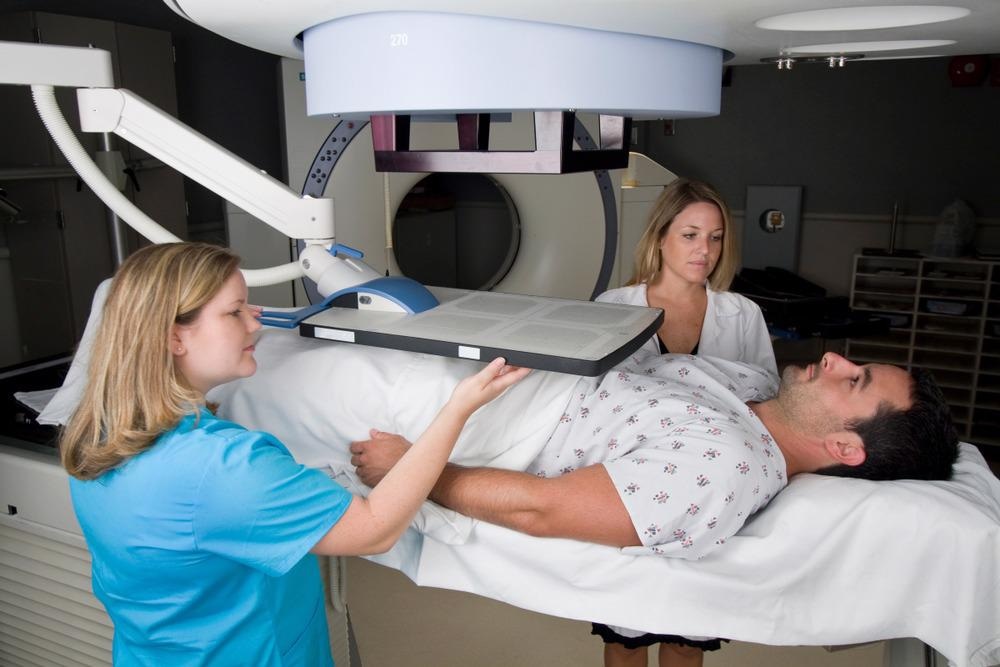Radiation therapy is one of the main treatment options for cancer. With the advancement of medicine and nanotechnology, there have been significant developments in this area that may revolutionize and innovate this traditional cancer treatment. Radiosensitizers are commonly used to enhance radiotherapy for cancerous areas compared to normal tissues. Researchers focused on improving radiotherapy have taken one step further, with a recent study assessing the novel usage of ultrathin gold nanowires for this very significant treatment method.

Image Credit: Mark_Kostich/Shutterstock.com
Radiotherapy is still the primary treatment option for cancer. It utilizes ionizing radiation consisting of X-rays that have the ability to damage cells and DNA. This is beneficial for patients as it causes cell death in cancerous cells. However, this toxicity also affects healthy cells, limiting the amount of radiation treatment that can be administered.
What are Radiosensitizers?
Radiosensitizers are compounds that can be combined with radiation and can aid in achieving a greater level of tumor inactivation. These agents can increase the dose intensity of radiation by a maximum level of 20-30%. Hypoxic cell sensitizers, which attempt to sensitize hypoxic cells to radiotherapy, and biological agents such as anti-angiogenesis drugs are examples.
With advancements in nanotechnology, there have been promising developments that aim to enhance the method of radiotherapy for cancer patients. Radiosensitizers that utilize heavy metals or high-Z nanoparticles have become a popular approach to improve the targetability for therapies and can also be used for precise targeting of cancer in radiotherapy.
The high atomic number of nanoparticles can increase and enhance the imaging signals, causing more X-ray interactions to occur. Along with their high surface area, this can ultimately assist in targeting tumor tissue more readily. The use of high-Z nanoparticles can aid in a more targeted radiotherapy delivery treatment and provide a more precise approach to differentiating cancer from healthy, which would enable less harm to healthy tissue.
Ultra-Thin Gold Nanowires for Cancer Therapy
The focal point of current research has been on spherical gold nanoparticles. However, a team of researchers has assessed the use of ultra-thin gold nanowires as a potential radiosensitizer. Their investigations were published in the Journal of Nanobiotechnology on September 11th, 2020.
Ultra-thin gold nanowires have been found to be a safely injectable radiosensitizer that can be administered into tumors to enhance radiation therapy. These nanowires are a novel type of high-Z materials, are one-dimensional, and have a narrow diameter of less than 5 nm.
When undergoing this assessment, researchers found was that newly-synthesized gold nanowires have a hydrophobic surface that disables them from being dispersed in aqueous environments, a challenging obstacle to overcome. Addressing this, the team coated the nanowires with PEGylated phospholipid, 1,2-distearoyl-sn-glycero-3-phosphoethanol-amine-N-[amino(polyethylene glycol)-2000], or DSPE-PEG (2000) Amine.
This investigation uncovered that DSPE-PEG (2000) Amine coated gold nanowires performed better than DSPE-PEG (2000) Amine coated gold nanospheres, observing increased production of radicals in solutions and cells during radiation. Gold nanowires have been observed to be superior to gold nanospheres with a higher enhancement ability of cellular oxidative stress, which may be due to being cell surface-bound and facilitating lipid damage.
The Future of Radiotherapy with Nanotechnology
Ultra-thin gold nanowires are a potential high-performing radiosensitizer that could innovate this traditional area of medicine
The use of gold nanowires would increase the damage targeted towards tumor areas and cancerous cells and decrease healthy tissue damage at the same time, raising patient care and quality of life. Furthermore, taking a more targeted approach to cancer treatment may provide a sustainable therapy for patients and the healthcare system.
Research into gold nanowires would advance the level of personalized medicine given to patients and is a significant step into a more innovative future in nanotechnology and medicine in general. However, while gold nanowires may be too long for direct cellular uptake, their potential as a radiosensitizer is promising. By combining these agents with small molecule therapeutics such as chemotherapeutics, the use of high-Z gold could provide radiosensitizing effects which maximize tumor control.
Gold nanowires have illustrated a significant potential for the role of nanotechnology in the future of radiotherapy, with lower toxicity than gold nanospheres and higher radiation enhancement in tumor areas. The application of this agent can be extended to other cancer types such as the brain or prostate; with potential advancement into a higher targeted therapy for cancer patients, this innovative radiosensitizer shows great promise.
References and Further Reading
Bai, L., et al. (2020) Ultrathin gold nanowires to enhance radiation therapy. Journal of Nanobiotechnology, 18(1). Available at: https://doi.org/10.1186/s12951-020-00678-3
DIPG.org. (2021) Radiosensitizers | DIPG.org. [online] Available at: https://www.dipg.org/dipg-treatment/radiosensitizers/
Koch, C., Parliament, M., Brown, J. and Urtasun, R., (2010) Chemical Modifiers of Radiation Response. Leibel and Phillips Textbook of Radiation Oncology, pp.55-68. Available at: https://doi.org/10.1016/B978-1-4160-5897-7.00004-4
Disclaimer: The views expressed here are those of the author expressed in their private capacity and do not necessarily represent the views of AZoM.com Limited T/A AZoNetwork the owner and operator of this website. This disclaimer forms part of the Terms and conditions of use of this website.